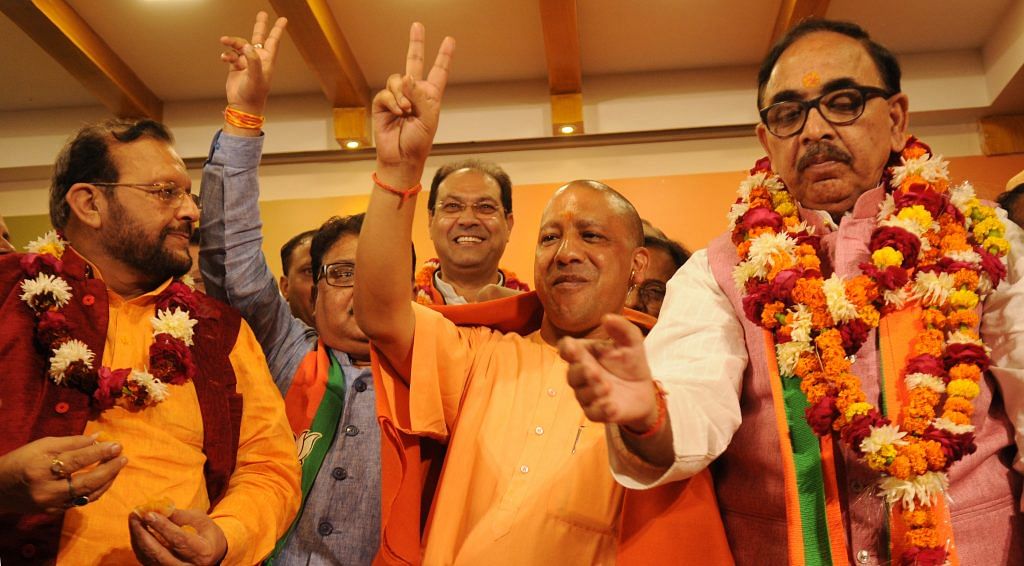Out of the 5,390 nagar panchayat seats for which results have been declared, the BJP could win only in 662 wards.
Politics is the art of perception management. It might not always be related to the truth, and the whole edifice might be built on propaganda.
The Uttar Pradesh civic body election results are a prime example of the BJP’s clever use of statistics. Before all the results were out, the BJP proclaimed it had swept the elections. The BJP had won 14 mayoral posts out of 16. If one makes an assessment just on the basis of this number, then the BJP had indeed repeated its performance in the assembly polls.
But as the party highlighted the mayoral victory, it hid the bad news buried in the nagar panchayat wards.
Even the newspapers got carried away by this projection and hailed it as another milestone for the party. It was fresh proof that voters are not unhappy with the demonetisation and the GST mess. The BJP said that the Gujarat assembly elections would produce similar results.
Is it smart propaganda or masterly use of data to convince people of Gujarat to not desert the party?
The BJP had swept the UP mayoral polls in 2012 as well, much before Modi and Yogi had arrived on the scene. The results on Friday are indeed a reaffirmation of BJP’s unassailable position in municipal corporations and its muscular organisational presence in big cities.
But the mayoral elections were just a small part of the elections. In two phases, the people of UP voted for more than 10,000 wards, 438 nagar panchayat chairpersons and 198 municipal council chairpersons. Out of the 5,390 nagar panchayat seats for which results have been declared, the BJP could win only 662 wards, whereas others won 4,728. This is not a happy situation for a party which had just recorded a landslide victory in this year’s assembly elections. Its strike rate is only 12.22 per cent.
In the municipal council member seats, the BJP candidates performed a little better. Out of 5,217 wards, the BJP managed to defeat its opponents in 914 wards. In other words, the BJP lost in 4,303 seats. Its strike rate was better in these polls – an improvement of five per cent to 17.53 per cent.
For chairpersons’ posts in nagar panchayats, BJP candidates vanquished their opponents in 100 seats, but also lost 337 (strike rate 22.83 per cent). For municipal council chairpersons’ posts, the BJP won 68 seats and lost 127, a strike rate of 35.35 per cent.
There is also a twist in the tale. The elections for civic bodies were held using EVMs, but the rest using ballot papers. This means that in polls conducted using EVMs, the BJP’s performance ratio is exceptionally high, i.e. 87 per cent. But wherever elections were held using paper ballots, the BJP’s performance was shockingly poor; though it is also true that the SP and BSP did not improve their performance. About 70 per cent of seats were won by independents. But the difference in results between polls conducted using EVMs and paper ballots can give a fresh impetus to the EVM controversy.
Akhilesh Yadav and Mayawati immediately raised the issue of EVM manipulation. They alleged that the BJP had lost badly where elections were held using ballot paper. Nobody knows when this mystery, if ever, will be solved, but one can infer that the BJP has definitely ceded ground in the last few months. It can also be deduced that there is a clear divide between big cities and small cities.
Big cities are solidly with the BJP, despite demonetisation and GST. In small cities, people are upset with the BJP, which is not a good sign for the party. In the 2014 parliamentary election, when the BJP won 73 seats out of 80 and in the 2017 assembly elections, the BJP was evenly supported by small towns and big cities. On both occasions, the BJP had achieved an unprecedented mandate.
What has to be analysed is if the fall is due to Modi’s rule at the Centre, Yogi’s performance in the last eight months, or both. Or is there something else which experts are unable to fathom?
Interestingly, the BJP lost in ward number 68 of Gorakhpur. This is the ward where the Chief Minister had voted. An independent candidate, Nadira Khatun, defeated the BJP’s Maya Tripathi.
Modi is a smart politician. He should not be misled by his own propaganda. Even if propaganda can help him split a few votes in Gujarat in his favour, if he has to succeed in the 2019 parliamentary elections, he has to find a reason behind the loss soon. Sure, perception is important, but sometimes reality can catch you unawares, to brutal effect.
